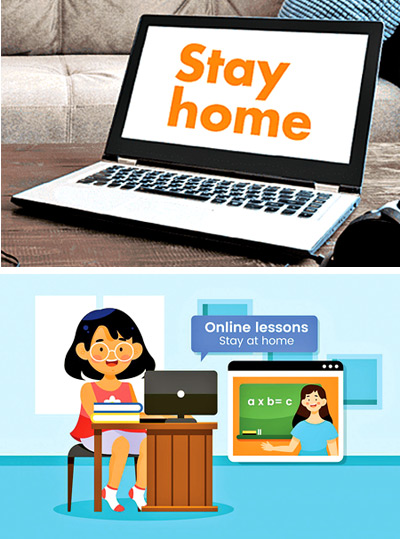
As the health hazards related to Covid-19 pandemic being unprecedented, more and more emphasis is being given on the exploration of new ways and means where the home front, digital technologies and data are thoroughly interconnected so as to make sure that the people and their businesses can remain healthy, stable and viable.
 ‘Stay at home’ may be the most heard, aired, advised and advertised phrase in the 21st century. Across the world, the regulations, orders and the encouragements given by the Governments in order to restrict the people’s movements during the pandemic are digitally disseminated through different hash tags such as #stayhome and #stay-home save-lives.
‘Stay at home’ may be the most heard, aired, advised and advertised phrase in the 21st century. Across the world, the regulations, orders and the encouragements given by the Governments in order to restrict the people’s movements during the pandemic are digitally disseminated through different hash tags such as #stayhome and #stay-home save-lives.
Consequently, since the latter part of 2019 and from the very beginning of 2020, working, studying and socialising while being at home have been the norm of the day. However, in some parts of the world notably in the developing countries, the provision of digital infrastructure is not yet in a satisfactory level for people to stay at home and attend to their personal and official requirements. The digital technologies and data can mediate the people’s ability of staying or leaving home; or to work from home.
Home is a haven

It is generally understood that home-front is a private entity which is separate from the collective institutions of the public life, most importantly the State and business. One of the central planks of the concept of ‘stay at home’ is its notion that home is a haven or sanctuary which is safe from disease transmission. It is also understood that home cannot be separated from the society and the world of politics; instead it is constituted through them.
Escalation of surveillance on digital technology is regarded as one of the most adverse aspects of ‘smart’ homes which have been growing. Smart appliances and systems are connected to wider networks and institutions which are not objectionable for the improvement of domestic convenience.
For instance, it is demonstrated that as to how the observation of the consumption habits through the smart phones are linked to insurance providers, variously having impacts on discipline subjects and premiums within the process.
As your behaviour at home is monitored by the insurers, service and utility providers, they are liable to get penalised. However, with the escalation of the Covid-19 crisis, the digital technologies have started to infiltrate into the homefront while rescripting the privacy related matters in the process.
In that light the emphasis should be directed on the element of Covid-19 pandemic digital technologies and data and as to how these three elements are trying to rescript the elements of home and privacy.
Working from home
The people’s ability of staying or moving beyond home can be observed by the applications with which their movements and the infection status get monitored. Also, it is evaluated as to how the property technology (‘proptech’) companies have intentionally or substantially utilised the pandemic as a platform to increase more and more surveillance on digital technologies in the residential buildings in a way where the issues faced by the tenants could be remedied. It is also explored as to how the digital platforms which have enabled studying and working from home have been able to reframe the privacy of home.
The orders and the suggestions given to stay at home increase the various interpretations given on home, particularly for those who are able to continue the employment as well as education while being at home. For a long time, home has been a place of work not just only for the domestic labour for people but also a place of study for children and young adults, even though it is not much acknowledged.
The present pandemic uses novel digital technologies which can promote the concept of ‘work from home’. With the eruption of the Covid-19, since 2020 working and studying from home have been made possible through a number of digital applications, while currently the same being the most accepted and the safest and the easiest.
Use of digital applications
At present, the highest used digital applications are the learning management systems, digital proctoring services (exam supervision) and teleconferencing services. For instance online conference facility ‘zoom’ has reported a 500% increase in interest while their rival ‘Microsoft teams’ reporting a 70% increase in the active users. Digital exams supervision platforms such as ProctorU, Proctorio and Examity, albeit once mostly confined to the dedicated distance specialist exam providers, distance learning providers or online exams providers, are currently the highest used in the higher education institutes which are involved with digital proctoring. With the escalation on the online classrooms in Universities, the use of these applications has also got highly expanded.
